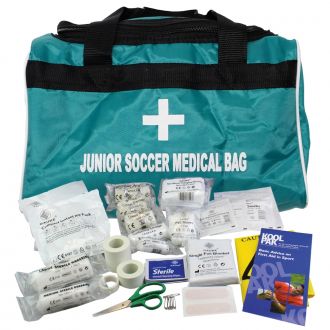Guide to Starting a Football Team: Making Your Own Football Club
“How to make a football club” is an increasingly popular question being asked by parents, coaches and league officials. A club is often the beating heart of a local community — giving people a common cause to get behind.
A grassroots football club gives young people a focal point. As well as promoting teamwork and community spirit, a local club can improve the physical and mental health of everyone involved.
If you need to know how to start a football team, you’ve already taken the most important step. Deciding to put time and effort into such a noble cause isn’t easy, as the process is complex and laborious. But all the hard work that lies ahead will be worth it when your team kicks off a competitive match for the first time.
We’ve created a comprehensive, step by step guide on how to make a football club. If you follow each step, your new club could be up and running within just a few months.
Administration Tasks For Starting A New Football Club
Starting a new football club doesn’t have to be a pipedream, but you’ll need a strong dose of reality before starting the process. A great deal of hard work lies ahead — and it starts with a series of administrative tasks.
Club Name
You can’t make your own football team until you’ve decided on a name. So many other decisions are dependent on this simple task, including league registration, kit manufacturing, recruiting players and advertising for players.
Your club name should reflect the community and the people in it. It’s probably something you’ll be stuck with for the lifetime of your club, so you need to choose a name that’s as catchy as it is meaningful.
To create your own football team that will stand the test of time, ask yourself a few questions related to your new club’s name:
- How can I best represent the local community?
- What are the values of my new club?
- Will any potential club name look appealing on merch, team kits etc.?
- Does the name roll off the tongue?
- Is the club name completely unique?
Club Crest And Colours
You can’t make a football team with easily identifiable colours and a club crest. Think of the biggest clubs in the Premier League — they can all be identified instantly by their kit colours and their badge.
Take the opportunity to be creative. Your club crest should be unique and meaningful; it should tell a story about either the club or the local community. Reach out to other people involved in the project for ideas and opinions. And try to imagine your club badge and colours on the pitch.
Appointing Club Officials
Ask anyone with experience how to make your own football club, and they’ll tell you that a strong team of officials is essential. Start at the top, and work your way down through the club hierarchy. Your first hires should probably be a manager/head coach, a secretary and a treasurer. Depending on your resources, you might have to assign extra duties to certain positions.
At the beginning of the club’s journey, it might well be that one person carries out all the managerial duties in a small grassroots football club. But as the club grows, the work might become too much. Fortunately, the growth of any club usually results in increased exposure and interest from potential candidates.
If you’re affiliating with the FA, for example, you’ll need a chair, a secretary and a treasurer, but it’s OK to give one person all three roles.
County FA Affiliation & League Registration
You’ll need to approach your county FA in order to affiliate with the English FA. A similar process is involved in the registering of clubs in Scotland and Wales. The registration process is relatively straightforward, but you need to ensure you provide all the information requested by the county FA.
Your county FA is basically the governing body for your new club. All rules, regulations and disciplinary procedures are enforced by the county FA, so you should avail yourself of them before kicking your first ball. In most cases, the club secretary will be responsible for communication with the local FA.
Find your local FA here, and reach out via email or telephone. You may also be able to begin the registration process on the county’s website.
Club Constitution
Whether you’re starting a kids football team or a pub team, you’ll need to create a constitution letter to ensure you’re compliant with the FA’s accreditation guidelines. This constitution should serve as a handbook for your new club, as well as a mission statement.
Make sure your constitution includes the following information:
- The name of your club
- Club objectives
- Details of your FA affiliation
- Subscription fees
- An equality statement
- AGM
- Voting rules
- Disciplinary procedures
You’ll find a full list of requirements for FA club constitution letters here.
How to Create Your Own Football Team: Forming The Team
Once you have taken care of the necessary paperwork and administration, the most important part of the process can begin — recruiting players and forming a team.
Recruiting Players
The best way to create your own football team from scratch is to hold trials. You’ll create a lot of interest in the community, which is great for your club’s image. But more importantly, you’ll get to see the talent available in your local area.
Advertise your trials via local news publications, community boards, social media and online discussion forums. But in many communities, the most important marketing tool is word of mouth. Tell your admin staff and coaches to put the word out. And reach out to local schools — many of them now have intranet systems that reach hundreds of pupils.
Other marketing channels might include:
- Door-to-door flyer delivery
- Setting up registration stalls at local markets
- Advertising on specialist websites such as Gumtree and Player Wanted
- Striking up mutually beneficial relationships with local radio and TV stations
Holding Football Trials
The last thing you should do when starting a new football club is allow trials to become free-for-all sessions. You’ll need to spend time organising your staff to ensure every area of the pitch is covered. For example, one coach might be responsible for spotting creative talent. Another might be responsible for organising matches. And another might be given the task of recruiting goalkeepers. Exactly how you distribute responsibilities is up to you. As long as every aspect of your trials has someone in charge, things should go smoothly.
Ideally, you should begin with a squad of 20 players for Saturday and Sunday leagues. For five-a-side teams, you should recruit a minimum of eight players.
Registering Your Players
To make a football team compliant and ready for action, you’ll need to register all your players with your county FA. This is the club secretary’s responsibility, although everyone can help to collate the necessary player information.
Once you have all the details, the club secretary must complete the registration process — usually online. Reviewing the registration details might take a few weeks initially. The county FA will need to check players are eligible, not registered with other clubs and not subject to disciplinary measures. The county will send you a formal notice upon clearing your players for participation in the league competition.
Costs Of Starting A New Football Club
You can’t learn how to create your own football team without learning about the costs involved. Unfortunately, these costs are the single biggest reasons why so many new football clubs fail within just a few months of registration.
County FA Affiliation & League Registration
To make a football team official, you’ll need to register and affiliate with the local FA — and this incurs a charge. The exact cost of registration depends on the county’s guidelines. Essex, for example, waived affiliation fees for the 21/22 season, due to the financial impact of Covid.
Contact your county FA for more details.
Pitch Hire
You can’t make your own football team unless you have somewhere to play. Unfortunately, the cost of pitch hire has skyrocketed over the course of the last decade. More and more local authorities are selling their pitches to raise cash, and that’s reducing the supply of pitches across the country.
Start the process of finding a pitch by contacting your local authority’s leisure department. There may be privately owned pitches available, but they’ll probably be more expensive to hire. Services such as Pitch Finder UK can help you to find pitches in your local area.
The average pitch in the UK costs between £500 and £1000 per year to hire. But it’s important to bear in mind that this fee only covers the use of a pitch for two or three hours per week during the season.
Pitch Equipment
If you hire a council pitch, the chances are you’ll have to supply your own football goals, corner flags and other items of pitch equipment. While it’s possible to hire such items, it makes more sense to buy them from a reputable football equipment retailer.
But if you hire a football pitch from a private landlord, goalposts, nets, corner flags and anything else you need is probably included in the price. Just make sure you check what is and isn’t included in the hire price before parting with any cash.
Team Kits
If you need to know how to make your own football club, the chances are you don’t have a kit supplier. Unless you can find a local company to buy the strips for you, you’ll have to use club funds to pay for strips.
If you’re starting a kids football team, the total cost of kitting out every player will probably be in the region of £150 to £300. If you’re starting a new football club for adults, the total cost could be anything between £250 and £650.
Shop around for the best deals. Some retailers offer discounts for bulk orders. You might also get discounts for kit purchases in the future.
Training Wear, Equipment & Accessories
There are a few items of football equipment that are crucial for training and matches:
- Shin pads
- Bibs
- First aid kits
- Boots
- Goalkeeper gloves
- Training cones
- Training markers
- Portable goals
- Coaching equipment
In some cases, your players may be able to help out by supplying their own equipment. Take an inventory of what you have, and create a shopping list before shopping around for the best deals.
Referees
Finding referees willing to officiate grassroots football games on a regular basis is not easy. And even if you can find some accomplished officials, you’ll need to pay them for their services.
On average, a referee would expect around £30 to cover their expenses. This is usually paid by the home team. The best way to cover this expense is through players’ subs. Ask every player who starts to contribute around £5 to club funds. And every player on the bench should be expected to contribute around half that.
Your club treasurer should keep detailed records of players’ subs. Collecting money isn’t easy, and it requires regular communication and up-to-date records. Consider fining players who fail to pay their subs on time.
Costs Summary
Below is a breakdown of the costs that you'll need to consider when setting up a football club:
| Item | Cost |
| County Registration | £0 to £150 |
| League Registration | £50 to £100 |
| Children’s Football strips | £150 to £300 |
| Adult Football Strips | £350 to £650 |
| First aid kits | £30 to £60 |
| Pitch equipment | £40 to £200 |
| Footballs (match and training) | £50 to £150 |
| Referee | £30 (Per Match) |
| Pitch Hire | £500 to £1000 |
You should be able to fund these purchases through subs, fundraising and sponsorships.
Fundraising For Your New Football Club
Fundraising is an essential part of any “how to make a football club” guide. Fortunately, there are several proven fundraising strategies used by grassroots football clubs.
Local Networking
Reach out to businesses, politicians and respected individuals in the area. Invite them to your games, and introduce them to your players. Making key people and organisations part of your journey will inspire them to help financially.
Make sure everyone in your club is taking every opportunity to wax lyrical about your club. Simply talking about it in social circles could be enough to generate interest — and lucrative sponsorships.
Classifieds
Place ads in the classified section of local newspapers, asking for donations and sponsors. You can also reach out to potential donors through online classified services such as Gumtree and Craigslist.
Social Media
Create social media accounts across all the main platforms. Follow influencers and local businesses, and take every opportunity to share photos and stories about your club’s progress. Engage with followers and play an active role in discussions to grow your following.
Club Days
Opening up your club to the public every now and then is a great way of getting exposure and developing new relationships with potential sponsors. Advertise at least two open days every year. Invite the public to attend training sessions, meet the players and speak with club officials.
Now that we’ve told you how to start a football team, it’s time to begin your journey!





